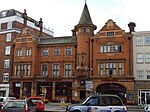Fulham War Memorial
Buildings and structures completed in 1921Grade II listed buildings in the London Borough of Hammersmith and FulhamMilitary memorials in LondonWorld War II memorials in EnglandWorld War I memorials in England

Fulham War Memorial is a Grade II listed monument at Vicarage Garden, Fulham High Street, Fulham, London.It was built in 1921 and designed by the sculptor Alfred Turner, and comprises a bronze figure of Peace on top of a high Portland stone pedestal with three steps. There is also a bronze kneeling figure of a cherub against a rough cross on base. The inscription is "To the Honour of Fulham's Gallant Dead" "They died for freedom" 1914–1918 and 1939–1945.
Excerpt from the Wikipedia article Fulham War Memorial (License: CC BY-SA 3.0, Authors, Images).Fulham War Memorial
Church Gate, London Parson's Green (London Borough of Hammersmith and Fulham)
Geographical coordinates (GPS) Address Nearby Places Show on map
Geographical coordinates (GPS)
| Latitude | Longitude |
|---|---|
| N 51.46889 ° | E -0.21124 ° |
Address
Church Gate
Church Gate
SW6 3LD London, Parson's Green (London Borough of Hammersmith and Fulham)
England, United Kingdom
Open on Google Maps










